News
In Search of Sanity

Our weekly 7th Sea game finished a few weeks back, and we have now started on another Pathfinder adventure path - this time Strange Aeons. For those who don't know, it's effectively a Lovecraftian horror scenario which begins with the characters waking up in an insane asylum with no memory of how they got there.
We've been playing Pathfinder on and off for the last few years now (some of us are in a monthly Serpent's Skull campaign that has been running for 3 years, and I've been running Rise of the Runelords on and off for about as long during our weekly game nights, one chapter at a time), so we're reasonably comfortable with the basic classes to want to begin experimenting a bit. I've taken a Spiritualist (so trying out the Occult classes as well), and we've also got an Inquisitor, a Shaman and a Swashbuckler with only the Rogue being a standard class (and even they are heading towards being an Arcane Trickster).
It does leave us with some interesting gaps in our line up, but then Strange Aeons could potentially be a non-standard adventure path so we might do okay if we're careful. The big range of mechanics options during character generation is one of the things I like about Pathfinder, but given the limited number of campaigns we've started there hasn't been much opportunity to try different options.
Our GM is very keen on all things Lovecraft, so was keen to run this path as soon as she heard about it (given how little interest there is from the rest of the group to play actual Call of Cthulhu, it seemed a reasonable compromise). I'm interested to see how much it plays like a Horror game rather than the kill-monsters-for-xp game that Pathfinder often is. Horror is also often about there actually being a serious risk of getting killed, whilst an Adventure Path sort of assumes that characters will survive (or at least, enough of them) for all six chapters in order for the story to play out. Pathfinder APs also assume that the PCs will win in the end - another difference to Horror games.
Though we're playing face-to-face, the GM has a lot of the notes and creatures defined in Roll20, using that to manage the game (much like I did for the previous episode of my Rise of the Runelords game). We still use tabletop miniatures for combat and mapping, so we get the advantage of streamlining the combat along with the advantage of real physical items on the table.
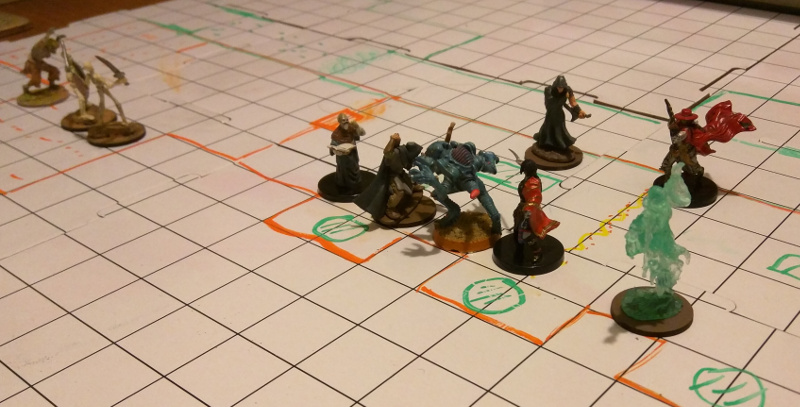
So far we've made it to second level, and are beginning to try to find out what has happened in the asylum. It does feel a bit horror-like at the moment, given that we have no clue what is going on and many of the things that we're meeting do seem to be quite insane. Only one of us has gone insane so far - my spirit, who turns out to be really bad at dealing with insanity. Since she's probably our best front line fighter at the moment, losing her could be bad.
The first two sessions have gone well, and it's been a lot of fun. We'll see how it progresses over the next few weeks.
For a somewhat abstract (probably spoiler filled) account of our adventures, I have a diary written from the point of view of my character. Assuming they survive long enough, I intend to keep it updated as our adventures continue.
Aristocrats
Running a Pathfinder campaign in a city means that the majority of people that player characters meet and interact with actually have NPC class levels. Even people they've had to fight have generally been Commoners or Experts. Some may have a PC level (such as an Expert/Rogue), but the NPC classes are useful for fleshing out the city.
I have a number of character templates set up in Roll20 which I can use as a basis for new characters. The latest batch are actually Aristocrats - members of the wealthy elite of the city. Are few of them are listed below.
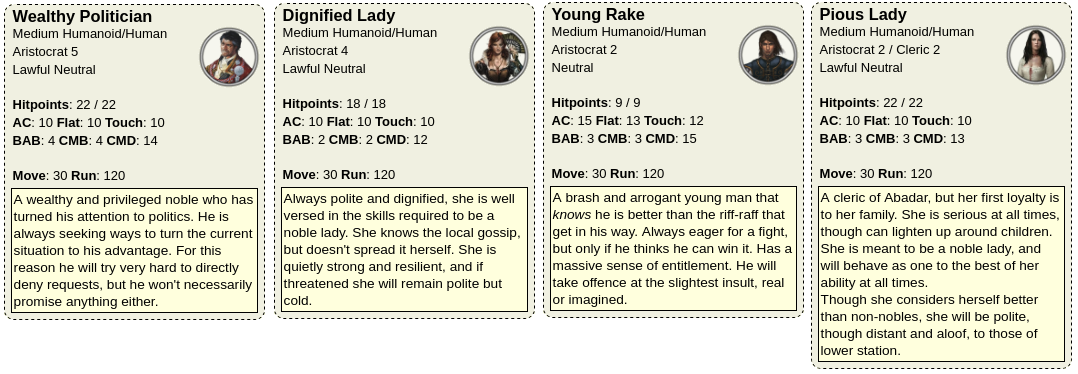
Rather than just listing these templates as Aristocrat 2, or Aristocrat 3, as I've done previously for the Commoners and Experts, I've decided to use the sort of naming scheme used in the Pathfinder Codex books - i.e. an adjective/noun descriptor, together with a bit of character background.
Since I use the Bio field in Roll20 for the physical description which players can see, I've updated my API scripts to output the GM Notes field of the character to the information block I can call up with a press of a macro. This reminds me of this character type's personality.
A second tweak outputs information from the token's GM Notes field, so if I want to add information to the particular instance I can do that.
Coupled with my random name generator, and random hitpoint setter, I can produce some noble NPCs with unique names relatively quickly during the game, or when writing an adventure. Given that I assume NPCs 'level up' more or less with age, most are in the range of levels 1-5.
So far I have 10 done (5 male, 5 female), and have another 10 portraits and tokens lined up waiting to be completed. I then might go back and rename some of my previous templates, though I'm quite happy with rogues and fighters which are actually named after the appropriate level titles from AD&D 1st edition.
Pathfinder Factions
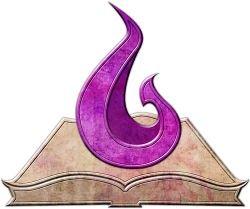 One of the ideas I'm playing with in my new Pathfinder campaign is the use of factions. Pathfinder already has rules for handling reputation with different factions, which is spread across several books (Ultimate Campaign, the Faction Guide and some mentions in various Pathfinder Society books). They all seem to handle it slightly differently, plus there are also the Influence rules in Ultimate Intrigue.
One of the ideas I'm playing with in my new Pathfinder campaign is the use of factions. Pathfinder already has rules for handling reputation with different factions, which is spread across several books (Ultimate Campaign, the Faction Guide and some mentions in various Pathfinder Society books). They all seem to handle it slightly differently, plus there are also the Influence rules in Ultimate Intrigue.
What I've gone for is, I think, slightly different to all of them, but uses the terminology from Ultimate Campaign. Just to be clear, these aren't the factions from the Pathfinder Society itself (though some of them may turn up), but factions specific to my campaign in and around the city of Magnimar.
There are a number of factions in and around Magnimar, and these are generally where plot quests are being driven from. So the city watch might put out a bounty on a known criminal, or ask for help dealing with a problem that a group of 'adventurers' are better dealing with. Success will generally provide 1 or 2 reputation points with The Law for all the characters involved, and open up awards unique to that faction which reputation can be spent on. Each faction has its own unique set of awards, but players don't know what they are until they've unlocked them.
The awards will tend to follow a theme for each faction though - some might provide access to equipment, others to retraining or just to information or physical aid.
Amongst the unlocked awards so far, Serpent's Run gives access to “A Daily Jog”, which allows a character to retrain their hit points. The Shucked Oyster provides “A spanking, a spanking” which allows reputation to be traded for experience points. The Dome of the Savoured Sting provides “Between the sheets”, which grants a bonus on a gather information check.
So far characters have only unlocked the first level on several factions, but the first few adventures are geared towards introducing them to a number of the more important ones in the city. As they get to work with different factions, they might decide that some are more useful than others and try to get involved more with one over another. It's also possible that a high reputation with one faction might be viewed negatively by a rival, so doing work for The Law might mean you are less likely to get work from various criminal groups.
There are also other differences between the factions. Some pay more than others for jobs, or are more (or less) likely to tell the whole truth about quests. The Streets can't afford to pay much, since it's requests for aid from the common folk, but their needs are generally simple and relatively safe, and having a good reputation with the townsfolk is always useful. Serpent's Run may be more interested in characters going out and capturing dangerous monsters for them to use in the arena, but only pay on success.
It's basically a mechanical bonus to supplement the role playing side of interactions between the characters and the environment they're in, and give me as GM a framework to try and provide some consistency in what the NPC factions are doing.
Roll20 Video
Sometime after we finished our D&D 3.5 campaign last year, Roll20 switched the engine it was using for WebRTC. Apparently this caused lots of problems for everyone, but I was hoping that these issues would be resolved by the time we started our new campaign.
It appears that I was being too optimistic, and we were unable to get more than three people working over Roll20's video chat (and the forum thread discussing the issues are still going strong). So we tried using Hangouts external to Roll20, but one person was unable to connect to this (not sure why, since Hangouts has always 'just worked' for me, on several different platforms).
In the end we tried appear.in, and this just worked without anyone needing to sign in and register. The only hiccup was one person with a delayed audio, which was rectified after a disconnect/reconnect.
So we've now disabled video/audio chat in Roll20, and are planning on using appear.in for future sessions. We still use Roll20 for text chat, and of course all the dice rolling, character sheets and mapping (at which it still excels), but the video chat seems to be unusable for us at the moment.
Fortress of the Stone Giants
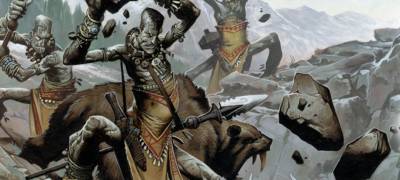
This week we finished our last session of the fourth Rise of the Runelords Pathfinder adventure, Fortress of the Stone Giants. This one seemed to take longer than any of the others, though part of that may have been due to several missed sessions which stretched things out.
As with all the adventures in the series (so far), it's very railroaded in its assumptions about how players will tackle it, but has some options to take some very wrong turns. Right near the start, there's a possibility to leap into the fifth adventure, which the group very nearly did (which would have possibly lead to a very quick TPK). Actually, that possibility is also at the start of the first adventure, where it suggests laying some clues to a hidden location (something I avoided doing, since I figured there was a high probability of them following up on them, and thereby ending the campaign very quickly).
For the final storming of Jorgenfist, there are multiple routes in, but it pretty much assumes they'll go in the front door. Going in the back door avoids plot clues, and more importantly avoids a large chunk of XP which means the PCs are lower level than they 'should' be by the time they meet the big bad. Fortunately for them they decided at the end of a fight that they were too badly beaten to continue, and fled out. Which gave me an opportunity to bring the plot to them and encourage them to explore a bit more first before leaping right to the end.
Having said all that, they did reasonably well. I've actually switched to using the medium XP progression for the adventure path (it recommends fast XP progression), which has given me the opportunity to add in some side quests and flesh out a few things. Despite the extra quests, they were still lower level at the end than they 'should' have been. They've finished the adventure at level 12, when it's recommended that they should be close to level 14.
From an adventure balance perspective, this was probably a good thing. It seems to me that the adventure is either a bit on the easy side, or my group is very well optimised. It may be a bit of both. The group's fighter can easily dish out over 100 hitpoints of damage a round, and the second front line character is almost unhittable (as well as also dishing out respectable damage). Few opponents last more than a round, so it's rare for the group to take lots of damage.
I have also allowing the use of Hero Points, and they did burn through quite a few of those (at least twice to avoid character death when fighting more magic orientated foes), so possibly it's not entirely one sided. Though Hero Points remove the threat of death to some extent, they're a limited resource that can't be easily recovered (gain one per level, to a maximum of 3, and you need to burn 2 to avoid death), so I'm reasonably happy with their use. For a railroaded adventure path like this, they're working well since they keep the campaign moving. I probably wouldn't use them quite so much in a more sandboxed game.
All in all, I think it went well, and players seem to be enjoying themselves (at least they say they are). The lower than expected character levels is making things more of an interesting challenge without making it too hard, and means I have the option of slotting in something between the end of this adventure and the beginning of the next one.
We're going to switch to a game of 7th Sea next, so I'll probably run the fifth adventure, Sins of the Saviours sometime later next year.
Vault of the Drow
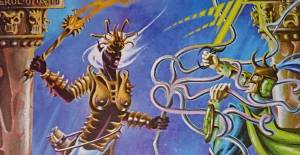 We have finally come to the end of the D&D 3.5 campaign I started over two and a half years ago. Starting at 3rd level, initially just as a short adventure to try out the online tabletop idea, it's seen the party climb up to around 28th level, giving the Epic level rules a try out. In the final battle against the servants of the Spider Queen, nobody died (though a couple came close).
We have finally come to the end of the D&D 3.5 campaign I started over two and a half years ago. Starting at 3rd level, initially just as a short adventure to try out the online tabletop idea, it's seen the party climb up to around 28th level, giving the Epic level rules a try out. In the final battle against the servants of the Spider Queen, nobody died (though a couple came close).
Originally set in the Hestmark Highlands of the World of Greyhawk setting, and initially going up against the machinations of the Scarlet Brotherhood, it ended with a delve into the underdark, as I ran everyone through a somewhat high level version of D1-3 (the classic 1st edition AD&D adventures going up against the Drow). These are some of the earliest adventures I ever bought (I also have G1-3, and Q1, but I ran people through G1-3 shortly after 3rd edition first came out), so it was good to finally make use of them. I have tried two aborted campaigns using them before, but previously nobody ever got past D1.
I've decided definitely against continuing the campaign into Q1 (Queen of the Spiderweb Pits). Though it might be interesting, I'm sort of burned out from coming up with challenges for a party of Epic level adventurers that doesn't simply TPK them.
Things I learnt: Epic rules are broken. The Book of Exalted Deeds is really broken (but at least I've now got to use all the books I bought 15 years ago and never used). Letting players buy whatever equipment they have money for is also something I'd like to avoid in the future. Since the game started as a simple dungeon bash where I didn't want to worry about what happened in downtime, there were a number of well optimised characters that could be very difficult to touch without bringing in encounters designed to exploit their weaknesses (which, from a realism point of view I don't like doing too often).
Having said that, it wasn't a cake walk for the party, and there were plenty of deaths (which became a very temporary thing once the cleric gained access to True Resurrection) as well as close calls, but they all managed to avoid any TPKs.
Roll20 worked very well as a virtual tabletop platform, though it was heavy on the macro programming and API scripting (something myself and several other players had no problem with, since we've done this sort of thing as our day jobs). For the less technically interested, it was a pain. However, we started long before Roll20 had support for character sheets, which abstracts away the need for a lot of this, so hopefully our next game will we somewhat easier to manage when we're able to take advantage of all the new features.
In terms of a next game, I'm planning on starting a low level Pathfinder game set in the city of Magnimar. I intend this one to be a lot less dungeon bashing, with more focus on the implications of what people are doing, with a bit more politics and social complications than the D&D game had. Since I prefer Pathfinder to any of the D&D versions, this was probably also the last game of D&D I'll run (though I did think that back in the early '90s when I converted by 2nd Edition game to something else).
Shrine of the Kuo-Toa
Our Epic take on the classic D&D modules D1-3/Q1 continues, and some weeks ago we finished D2 - Shrine of the Kuo-Toa. Since a dungeon crawl doesn't really suit Epic level play, this adventure didn't play out at all like it was originally designed, and instead became a diplomacy mission to gain the aid of the Kuo-Toa against the Drow.
As it happens, the Kuo-Toa have an artifact that will help in a fight against Lolth, and the PCs managed to secure this after defeating a Drow Matriarch who was causing problems for these Kuo-Toa.
The map is something I drew/traced over a year ago, before I realised that such a map really wasn't going to be suitable by the time the PCs reached this area.
Beyond the Warrens
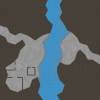

The first part of the Underdark portion of my D&D 3.5 Roll20 campaign has been completed, with the party well out of D1 Descent Into the Depths of the Earth and rapidly approaching D2 Shrine of the Kuo-Toa. To mark this occasion, I've uploaded some of the maps that I've used recently to the campaign page.
Since the party has now reached 25th level, we're beginning (some might say we started a long time ago) to push the limits of the D&D game system. The Epic rules make normal adventuring really difficult, and given that the campaign was based around simple dungeon bashes this is making things hard. Whilst it may be suited to taking on single large creatures of high CR, the imbalance becomes very obvious when the adventure is in a small Drow settlement where even making a few NPCs level 20 doesn't make a lot of sense.
Part of the problem has probably also come down to the easy availability of magic items. A long time ago (about 2 years and about 20 levels or so) I decided that this was just going to be a simple sequence of dungeon bashes to try out playing in Roll20, and all downtime was abstracted to the point where any magic item could be purchased as long as the PC had the cash, and the item was within the GP limit of the town they were based out of. This does allow PCs to build highly optimised characters.
At this point I've decided to try and bring things to a close relatively quickly. We still have D2 and D3 to complete, as well as Q1 (which will probably be better suited for Epic play), but I'm not going to stretch it out any further than I have to.
However, it has given me an opportunity to finally use many of the books I bought but never used for d20, and I'm even using adventures I bought back in the early '80s for 1st edition and using them for the first (and probably last) time.
The Hook Mountain Massacre
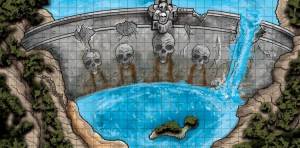
We've just completed the third part of the Rise of the Runelords adventure path for Pathfinder, bringing us to the halfway point with the characters at 10th level. We have a fairly straightforward set of characters - a Sorcerer, a Fighter, a Thief and a Cleric. For this chapter in the path, we switched to using the Pathfinder Unchained rules, and also to using the medium experience point progression (we had been using the fast progression, as recommended in the adventure).
If you're planning on playing in this, there may be spoilers ahead.
With a slower progression, I was able to bring in a few side quests to flesh things out a bit and introduce some more of the setting to the players. Not all side quests were followed up, and indeed some parts of the main adventure weren't completed so the party only just made it to 10th level by the end. This wasn't a particular problem though.
The fighter in particular feels way overpowered for the sort of foes they are going up against. The fight with the Gruals was particularly easy with most of them going down in one round, and though some of the ogres in Fort Rannick could hit hard, they also went down quite quickly. Standard ogres were pretty irrelevant (the majority being taken out with a single fireball).
The most dangerous critter in the whole adventure was the construct at Skull Crossing, which came close to TPKing the party, even though this didn't feel like it was meant to be hard. The biggest surprise was that the party failed to open the floodgates on the dam, mostly because they really didn't want to use the Thassilonian device. Shortly afterwards the dam burst, wiping out Turtleback Ferry (they had fortunately removed everyone's tattoos very early on) and flooding Whitewillow (as well as numerous settlements downstream).
They completed the adventure though, slaying Barl and finding the hint to take them back to Sandpoint. However, they aren't quite viewed as heroes by the locals.
This third part of the path felt a lot more of a straightforward hack and slash than the previous two, with the exception of the sudden moral quandary at the dam that I really wasn't expecting given how the characters had been played previously. It's also starting to suffer from the old D&D problem of power creep, and even though everyone has core classes, the differences between the character builds are starting to become very apparent (the fighter is the strongest character, the cleric the weakest, with the thief and sorcerer somewhere in the middle).
I'll probably run the 4th adventure (Fortress of the Stone Giants) at some point (maybe next year), though I don't have a burning desire to continue things right now.
Next up for our weekly gaming, we are probably going to be going back to Legend of the Five Rings, and I might start thinking about preparing some Savage Worlds.
Descent Into the Depths
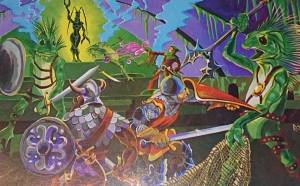 After getting sidetracked to deal with a Scarlet Brotherhood Necromancer (and then sidetracked to find a way to destroy the Eye of Vecna), the party of now (mostly) Epic Level adventurers have begun their Descent into the Depths of the Earth in our weekly Roll20 D&D 3.5 game.
After getting sidetracked to deal with a Scarlet Brotherhood Necromancer (and then sidetracked to find a way to destroy the Eye of Vecna), the party of now (mostly) Epic Level adventurers have begun their Descent into the Depths of the Earth in our weekly Roll20 D&D 3.5 game.
Many months ago they dealt with an uprising of giants and goblins which had been engineered by the Drow Priestess Jhultana. She was dealt with, though they found mention of someone called Eclavdra of House Eilservs who was apparently managing it all from a location deep in the underdark. Having now dealt with all other business, they are now heading town the wide tunnel they discovered beneath the goblin caves.
About 10 miles along, and about 1 mile deep, they encounter a region of null magic (which given most of them are relying on items and supernatural effects to be able to see meant it suddenly went dark). The lighting of torches to progress further alerted ogres and giants up ahead to their presence, and they immediately came under attack by rocks and clubs from ogres and giants, which without the benefits of their usual magical protections was significantly more deadly than they were expecting.
Pushing forward (either on foot or by a teleport across the region) they encountered further stone giants, as well as Drow warriors and clerics. The party's wizard only just survived her own meteor swarm (thanks to a friend shield ring with the dwarf), and along with a horrid wilting (a greater meta magic rod of quickening taken from the previously mentioned necromancer) managed to clear things down of enough spell-buffed (unholy aura and other effects) drow to allow the cleric out of the silence'd area to start bringing her spells into effect.
The Druid (shapechanged into various creatures, including beholders and pit fiends) drove off reinforcements, and the Drow High Priestess in charge of the checkpoint was defeated with a single very unlucky fear save (she rolled a '1' when facing the Druid-Pit Fiend) just before she was going to rip the wizard apart with her tentacle rod.
In the end, the checkpoint was secured with only one party death (the rogue, who's ring of blinking failed him just before a much needed Mass Heal) and a couple of near deaths. It was one of the toughest fights in a while, and could have easily resulted in a lot more deaths, if not a TPK if things had gone slightly differently.
They now have a charmed Drow female, a blinded Drow male and an epic-level intelligent tentacle rod that very much wants to kill them, as well as a heavily fortified Drow checkpoint to explore.

